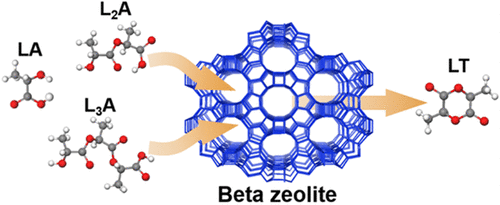当前位置:
X-MOL 学术
›
Chem. Mater.
›
论文详情
Our official English website, www.x-mol.net, welcomes your feedback! (Note: you will need to create a separate account there.)
Breaking the Si/Al Limit of Nanosized β Zeolites: Promoting Catalytic Production of Lactide
Chemistry of Materials ( IF 8.6 ) Pub Date : 2020-01-10 , DOI: 10.1021/acs.chemmater.9b04023 Qiang Zhang , Sheng Xiang 1 , Qing Zhang 2 , Binju Wang 3 , Alvaro Mayoral 2 , Weiyan Liu 2 , Yuyao Wang , Yinghao Liu , Jing Shi 4 , Guoju Yang , Jun Luo 4 , Xuesi Chen 1 , Osamu Terasaki 2 , Jean-Pierre Gilson 5 , Jihong Yu
Chemistry of Materials ( IF 8.6 ) Pub Date : 2020-01-10 , DOI: 10.1021/acs.chemmater.9b04023 Qiang Zhang , Sheng Xiang 1 , Qing Zhang 2 , Binju Wang 3 , Alvaro Mayoral 2 , Weiyan Liu 2 , Yuyao Wang , Yinghao Liu , Jing Shi 4 , Guoju Yang , Jun Luo 4 , Xuesi Chen 1 , Osamu Terasaki 2 , Jean-Pierre Gilson 5 , Jihong Yu
Affiliation

|
Efficient production of lactide (LT) from highly concentrated lactic acid (LA) based on β zeolite catalysts is highly desired for an economically sustainable polylactic acid (PLA) industry. Like any zeolite, the Si/Al ratio of nanosized β zeolite needs to be adjusted to fit the requirements of different industrial catalytic processes. However, varying its Si/Al ratio above 100 or below 20 while keeping the crystal size within 100 nm remains a challenge. We successfully prepared nanosized β (10–106 nm) with broad Si/Al ratios (6–300) by l-lysine-assisted two-step crystallization in a concentrated gel system. The crystallization process of the nanosized β zeolite was studied. Significantly, the as-prepared β-15-10 catalyst (Si/Al = 15.5, size = 10.1 nm) with the lowest Si/Al ratio and the smallest particle size shows the highest LnA conversion (n = 1–3) and LT yield (74%) in the conversion of highly concentrated LA (105 wt %). Importantly, not only LA/L2A but also L3A existing in the highly concentrated LA could be converted to LT. This is the result of a fast LT production promoted by the increased Brønsted acid site density and its rapid diffusion out of the nanosized crystals avoiding secondary reactions, namely, decyclization and oligomerization. The reaction pathways from L3A/L2A to LT were elucidated via density functional theory (DFT) calculations.
中文翻译:

突破纳米β沸石的Si / Al限制:促进丙交酯的催化生产
对于经济上可持续的聚乳酸(PLA)工业,非常需要基于β沸石催化剂的高浓度乳酸(LA)有效生产丙交酯(LT)。像任何沸石一样,需要调整纳米β沸石的Si / Al比以适应不同工业催化工艺的要求。然而,改变其Si / Al比在100以上或低于20同时将晶体尺寸保持在100nm以内仍然是一个挑战。我们成功地制备纳米尺寸的β(10-106纳米)具有广泛的Si / Al比(6-300)升赖氨酸辅助的两步结晶,在浓缩凝胶体系中进行。研究了纳米β沸石的结晶过程。值得注意的是,所制备的具有最低Si / Al比和最小粒径的β-15-10催化剂(Si / Al = 15.5,尺寸= 10.1 nm)显示出最高的L n A转化率(n = 1-3)高浓度LA(105 wt%)的转化率和LT产率(74%)。重要的是,不仅LA / L 2 A而且L 3高度集中的LA中的现有人员可以转换为LT。这是由于增加的布朗斯台德酸位点密度及其快速扩散出纳米级晶体而避免了次级反应(即脱环和低聚)而促进的快速LT生产的结果。通过密度泛函理论(DFT)计算阐明了从L 3 A / L 2 A到LT的反应途径。
更新日期:2020-01-10
中文翻译:

突破纳米β沸石的Si / Al限制:促进丙交酯的催化生产
对于经济上可持续的聚乳酸(PLA)工业,非常需要基于β沸石催化剂的高浓度乳酸(LA)有效生产丙交酯(LT)。像任何沸石一样,需要调整纳米β沸石的Si / Al比以适应不同工业催化工艺的要求。然而,改变其Si / Al比在100以上或低于20同时将晶体尺寸保持在100nm以内仍然是一个挑战。我们成功地制备纳米尺寸的β(10-106纳米)具有广泛的Si / Al比(6-300)升赖氨酸辅助的两步结晶,在浓缩凝胶体系中进行。研究了纳米β沸石的结晶过程。值得注意的是,所制备的具有最低Si / Al比和最小粒径的β-15-10催化剂(Si / Al = 15.5,尺寸= 10.1 nm)显示出最高的L n A转化率(n = 1-3)高浓度LA(105 wt%)的转化率和LT产率(74%)。重要的是,不仅LA / L 2 A而且L 3高度集中的LA中的现有人员可以转换为LT。这是由于增加的布朗斯台德酸位点密度及其快速扩散出纳米级晶体而避免了次级反应(即脱环和低聚)而促进的快速LT生产的结果。通过密度泛函理论(DFT)计算阐明了从L 3 A / L 2 A到LT的反应途径。


























 京公网安备 11010802027423号
京公网安备 11010802027423号